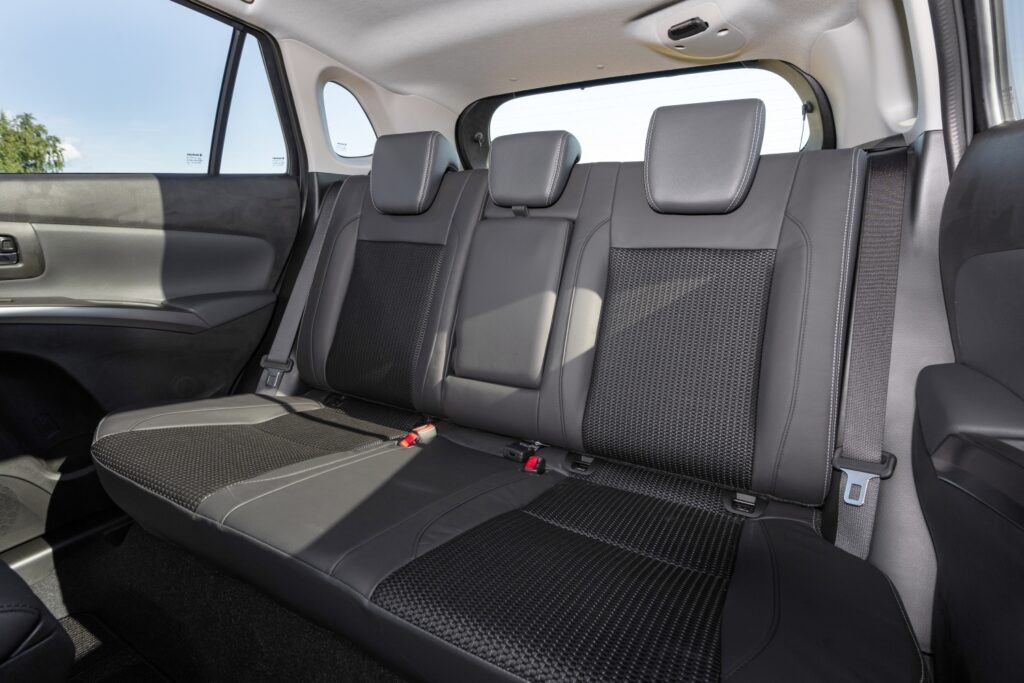The Suzuki name is arguably more associated with small SUVs than its regular family hatchbacks – indeed, it’s been making cheaper 4x4s for decades.
Simple, cost-effective and sometimes with a hint of utilitarianism, Suzuki is the budget brand that promises value for money.
Its latest project has been to increase the amount of electrification in its S Cross crossover.
As a result, there’s a slight name change. The ‘Hybrid’ is now the ‘Mild Hybrid’. The ‘Full Hybrid’ is new – and what we’re testing here.
It blends a 1.5-litre four-cylinder petrol engine with an electric motor, producing 115PS.
Entry-level Motion trim gets you smart alloys, keyless entry/start, heated front seats, front and rear parking sensors and gear shift paddles. You also get a reversing camera, a seven-inch infotainment touchscreen with DAB radio, Apple CarPlay and Android Auto, plus a 4.2-inch information display.
Ultra trim adds Suzuki’s Allgrip four-wheel drive system, a nine-inch infotainment screen, a 360-degree camera, a double-sliding panoramic sunroof, leatherette upholstery and SatNav.
The Full Hybrid is also offered with an automatic gearbox, which is a six-speed.
The Ultra trim is tested here, which includes the Allgrip system.

You can’t really tell the Full Hybrid apart from the rest of the range. The front has an open-mouthed grille with a horizontal chrome bar, a modest lower grille, and fog lights on either side.
The sides feature a small door crease and cladding around the wheel arches. Meanwhile, around the back, there’s an all-black panel and a diffuser-like piece of bodywork at the bottom.
Overall, it doesn’t look bad but it’s not a design that will warrant a second glance. And when you compare it with the more outrageous designs that the likes of Kia are sporting nowadays, the S Cross is in danger of looking dated already.
The interior is much the same. Yes, there are bits of silver, but the materials used feel a bit cheap and nothing about the design screams ‘next generation’.
The infotainment screen is housed in a shapely unit that peaks over the top of the dashboard. Again, it looks okay, but compare it with, say, the Kia Niro’s interior, and you’ll quickly realise there’s no contest.
The infotainment system is functional and crisply clear but a bit slow to respond to inputs. This is frustrating if you want to change things on the move, although at least physical air conditioning controls are still included.
Overall, the S Cross feels well-built and sturdy, but the appearance does little to inspire.

Hybrids often have decent acceleration because there’s an engine and an electric motor helping power you along.
Not so the S Cross Full Hybrid, which takes a slothful 13.5-seconds to get up to 0-62mph, barely making use of the extra power provided by the electric motor.
The automatic gearbox doesn’t help much and feels rather clunky. Indeed, you find yourself thrashing it to make anything resembling half-decent progress.
Handling isn’t bad, though; the suspension controls the body roll well. At the same time, the grip is good, but the steering doesn’t weight up sufficiently to give you much confidence in the bends.
Ride comfort on the road is fine at all speeds, but the Mild Hybrid version feels superior in absorbing bumps and potholes as there’s less weight.
If you’re into off-roading, the S Cross comes alive, tackling reasonably rough terrain very well.
As a result, it’s better as a low-speed vehicle.
While driving around town isn’t helped by its size, the acceptable ride, light steering and lack of grunt mean it’s decent in heavier traffic where performance isn’t an issue.


There is no electronic seat adjustment in the S Cross, so you must manually adjust your seat to find a comfortable driving position.
Once you do, though, the seats are pretty snug, but the lack of lumbar support is a concern if you’ve got a dodgy back.
The seating position is reasonably high, while visibility out of the front is good, thanks to the pillars being kept as thin as possible.
Although the rear pillars are thicker, there’s still a good view, helped by the 360-degree camera in the test car.
The interior is spacious with a commendable amount of legroom, while headroom is also plentiful despite the panoramic sunroof (also exclusive to Ultra trim). There is also a couple of cupholders, a generously sized glove box and a central cubby.
Sadly, though, the boot space really lets it down. Whereas the non-hybrid S Cross offers 430 litres, this is reduced to just 293 litres in the Full Hybrid to accommodate the electric motor and batteries.
This increases to just 665 litres with the rear seats folded down in a 60/40 split.

The Full Hybrid manages a claimed 48.7mpg, which isn’t bad considering it’s a four-wheel drive SUV with an auto ‘box.
It produces 132g/km of CO2, meaning road tax isn’t going to break the bank.
The battery can cut the engine when cruising, but that’s about it.
The emissions might be reasonable, but in today’s world of low-emission incentives, company car users are better off looking at plug-in hybrids or even all-electric cars.
Servicing costs should be inexpensive, and Suzuki has an excellent reputation in terms of reliability.
Despite this, it’s only backed up by a bog-standard three-year, 60,000-mile warranty, but hopefully, unless you’re unlucky, you won’t need it.

All things considered, the Suzuki S Cross Full Hybrid is not bad.
But the lack of drivability from the Full Hybrid’s powertrain and the reduced practicality is a letdown.
The Suzuki is not ugly by any means, but its exterior design still has a whiff of yesteryear about it, as does the interior. And, alas, the infotainment system is low down the rankings.
Nevertheless, the S Cross is very generously equipped and excellent value for money when you consider the cost of most hybrid 4x4s – so it still ticks plenty of boxes.









Leave a Comment
You must be logged in to post a comment.